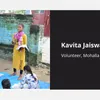How the Akanksha Foundation ensured that 95 percent students returned to school after the pandemic
Serving children from mainly underprivileged and migrant families, Akanksha’s approach also focused on emotional well-being and mental health
In India, March is usually a happy time for students who wait for the end of the academic year, followed by two months of summer vacation.
But March 2020 was different. With the outbreak of a global pandemic, the face of education was set to change for ever. According to a report by UNESCO, more than 298 million students from 15 lakh schools across the country were told that they could not return to school…indefinitely. Students from more affluent homes who attend private schools quickly segued to an online model with easier access to laptops and tablets. Those who come from families with no access to multiple devices (often relying on a single-shared mobile phone) and patchy internet connections, not only failed to advance in their academics, many have regressed and have fallen behind their peers.

More than two-thirds of the students who attend the Akanksha Foundation's schools come from families relying on a daily wage income
The decision to resume offline learning has come as a relief for most children from lower economic segments as it gives them a chance to come back up to speed with their learning. However, with many children coming from homes where a parent lost their source of income, dropping out to join the workforce to support the family has not been uncommon.
According to the Ministry of Education, more than three million children are no longer in school. Unofficial estimates place the dropout rate at a far more alarming 20 million.
Back to school
The government and NGOs have been making significant efforts to encourage students to go back to school. Among them is the Akansksha Foundation (Akanksha), a non-profit organisation that has been educating children from low-income homes across Mumbai and Pune for over 30 years. Since starting as an after-school programme in 2007, today Akanksha runs 27 schools in Mumbai, Pune and Nagpur with 575 teachers and 10,000 students.
With schools reopening, Akanksha has seen over 95 percent of their students return to school. This is a significant achievement, given that the majority of students come from families where the parents are migrant workers.
Speaking on the success of their back-to-school drive, Saurabh Taneja, CEO, , says, “Nearly 67 percent of our students are children of daily wage earners and through our efforts, we were in constant touch with 90 percent of them and took immense care of their socio-emotional well-being. Our teachers made regular calls to students and any cases of trauma or abuse were flagged to our partner organisation Arpan.”
The underlying cause for this success has been Akanksha’s Socio Emotional and Ethical Learning (SEEL) curriculum, which is not only an educational outreach programme that involved both students and parents, but also had additional social impact with preventing girls being married off as minors, and children being forced to become bread winners.
“We have also begun mapping the learning gap caused due to the pandemic among children with the help of technology across our schools and children. This is critical to ensure remedial measures and curriculum modifications are put in place at the earliest to bring the children up to speed. We believe more collaboration and partnership is needed in this aspect to come to a common, comprehensive, and holistic approach,” says Saurabh.
A three-pronged approach:
Akanksha’s success in bringing students back to school can be attributed to a unique approach that focused not only on academic learning but also on emotional well-being and engaging with students’ families and the community.
Learning: Akanksha is using technology across its schools to get a sense of how the pandemic impacted the students, identify, and fill in the learning gaps. The use of technology in the classroom has been designed to acclimatise students to a blended hybrid model that is being increasingly adopted today.
Nurturing: In addition to academics, Akanksha also focuses on the socio-emotional development of its students. The SEEL curriculum, which has been developed in association with the Dalai Lama Trust and Emory University is part of the students’ daily timetable. The SEEL programme is the main reason for the high number of students returning to school after the pandemic, an educator at a partner school undergoes a four-day training programme that enables them to teach students. The primary goal of the programme is to teach self-awareness and build resilience to emotional crises through group activities, yoga and meditation, and mindfulness. A teacher who wishes to train other educators must undergo an advanced cognitive-based compassion training module.
Engaging: Akanksha also works with parents and the community as part of its mission. They believe that parents are their partners in the learning journey and provide intensive support to empower parents in the areas of community health, economic resilience, and learning facilitators.
“Our educators, helper didis, and social workers went to great lengths to ensure every child is able to attend virtual classes during the lockdown. Once schools reopened we saw 95 percent of our students returning to school. The main focus now is to seamlessly integrate students back to the classroom environment. We aim to do this by leveraging technology and introducing blended learning in classrooms. At the same time, at a macro level, we aim to make the blended learning ecosystem accessible to the children we serve,” Saurabh says.
Edited by Teja Lele







